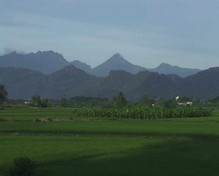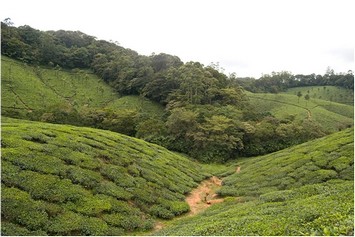Agasthya
A newsletter on the Natural History, Ecology
and Conservation of the Agasthyamalai region, Western Ghats, India.
ASHOKA TRUST FOR RESEARCH IN ECOLOGY AND THE ENVIRONMENT
Centre for Excellence in Conservation Science
Royal Enclave,Srirampura,Jakkur Post
Bangalore-560064
Telephone: 080-23635555 (EPABX)
Fax : 080- 23530070
Any and all opinions expressed in this newsletter are solely those of the author(s) and do not reflect the opinion of ATREE.
Editorial Team
Editor: T. Ganesh
Associate editor: Vivek Ramachandran
Editorial Review: R. Ganesan, M. Soubadra Devy
Design and presentation: Vivek Ramachandran
A S H O K A T R U S T F O R R E S E A R C H I N E C O L O G Y A N D T H E E N V I R O N M E N T
Corridors: the jugular of the forests through sterile tea
-Anand Mohan and Sandeep Das
Corridors as 'life lines'.
Photo: Sandeep Das
Necessity and pressure, they say, provoke innovation. Neither "necessity" nor "pressure" comes close to describing what we experienced when our first project proposal was shot down, and demanded that we present another within the hour. So, we decided to study the forest corridors within the tea plantations at Kodayar, to see how avifauna use them for feeding or movement, by assessing feeding guilds and the vertical strata occupied by the birds.
We chose systematic random sampling using point counts as our sampling method, and the primary forest as control. Completely unfamiliar with conducting scientific field studies, we felt glad that the tough part was done with and we looked forward to birding. But only when we set out for a trial run armed proudly with a pre-designed data sheet, did we learn that there are a million things on field that can completely alter plans drawn up on paper. Accounting for these factors and improvising accordingly was something we learnt the hard way, by getting lost in Kakachi and misplacing our binoculars. At the end of the three days, we had over 1000 minutes of data that had to be analyzed for patterns and anomalies applying our newly acquired skills. One of our more important observations was that 6 out of the 8 Western Ghat endemic bird species were found to be using these corridors. The species richness as well as abundance of birds was not significantly different and the community was 93 % similar. The strata use by birds in primary was more uniform but in the corridor habitats they preferred the canopy.
In a time when the human population has rendered land one of the scarcest and most sought after resources, clearing of forest areas and the resulting fragmentation pose a major threat to forests. Studies on conservation of corridors, at a local as well as regional level, might be a possible way to ensure wildlife, pollinators, dispersers movements and facilitate many natural processes essential for the survival and persistence of all flora and fauna.








